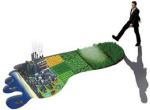The purpose of this entry is to briefly analyze the effects and the causes of the population in the environment of our planet.
Our population now ( 2011) is almost 7 billion, a huge number that reflects to the continuous expansion of our spice. Someone will say “so what”?, but here comes the numbers that soon or late all of should take under consideration.
This extremely fast growth makes the scientists to see that soon or late the Earth will reach its carrying capacity. This enormous exponential growth made the scientific community the red alert. By 2050 the population growth will skyrocket according to the graph bellow.

First of all the numerous technological innovations make the human to spread in each corner of the Earth in an amazing rate. These technological innovations can be translated into the increase of the food production, more consuming goods and of course better health system
Cassandras vs Cornucopians : Two theories in contrast
Cassandras gave us a prediction that soon or late our Earth will not be able to sustain such enormous population growth. Their main argument is that Earth can support only a certain level of people because the resources are not many. Famine and source depletion is among their predictions for the future.
Cornucopians argue that the technological innovation will overcome the difficulties that will occur in the future for the human kind. They also say that our resources are endless and as more humans will be on Earth they will be able to use more resources.
In my opinion the things are not so devastating. The Doomsday will never happen. What I’m trying to say is that technology is able to find solutions beyond the imagination. This idea to reduce our population makes me sick.
For example we see only the image of a problem, and we don’t see who the “painter” is, in other words who put us in the certain way of living. They make most of the people to blame their selves for something that others instrumented with such an excellent way. For example, our cars pollute. No one gave us the opportunity to choose another fuel that doesn’t pollute and as “BAD humans” we choose the most pollutant. I believe that there are other fuels that are extremely environmental. We don’t use then because some huge economic interests doesn’t want to. Up to this point I want to say that we don’t see the real problem we only see its easy to see.
Paul Ehrlich

Paul Ehrlich is an American biologist born in 1932. His career as professor in the Stanford University makes him unique in his sector. He is also an entomologist which his studies specialized in butterflies. However his book Population Bomb in 1968 make him famous.
According to Ehrlich the rapid population growth will cause global famine and increase also of the global death rate.
Population has been growing faster than Ehrlich predicted Moreover, some of his predictions doesn’t came true.
He created the IPAT Model
I= P x A x T
The equation analyzes the numerous factors that contribute to the human impact on the environment.
— Population =P
— Affluence = A
— Technology = T
The IPAT model in different countries
In each country of the world the population growth rate is different and the countries according to the IPAT model that are leaders isChinaandUSA.
China
In China Population , affluence and technology the three factors of the IPAT model have a huge impact on the environment. Chinais the country with the largest population in the planet and the problems that is facing is the huge increase of population and this causes other problems such as place for people and food. The one child policy in 1978 hasn’t solve the problem of the huge population in the environment. The population of Chinanow is 1,333,464,000
USA
InUSAthe factors that contribute to the impact in the environment are the technology and affluence. According to many researches and scientists the consumption rate of theUnited States of Americais so huge that only 2.3 billion people will be able to exist in the planet. The Population of USA now is 307,016,550
Greece
InGreece the birth rate should increase because the population and actually the economic system of the country will face in the future gigantic problems. The population of Greecenow is 10.760.136
Hans Rosling

Hans Rosling is a Swedish medical doctor, public speaker and a statistician. He is also, creator of the Trendalyzer software system, which actually converts statistics into moving interactive circle figures. He gave many speeches in Latin America, Asia, and Africa.
Something that impressed me in his amazing speech was first of all his extremely amazing humour and of course his point of view about economic and population growth. His interactive dataset was amazing with briefly explanations in many parameters which was extremely enlighten.
References :
Us Population Retrieved May 9,–2011
From http://www.census.gov/main/www/popclock.html
Wikipedia. Hans Rosling . Retreived May 9—2011
from http://en.wikipedia.org/wiki/Hans_Rosling
Withgott, J. Brennan, S. (2010). Environment. The Science behind the Stories. 4th Edition, San Fransisco : Pearson EducationCultural Evolution.
Video : Population growth , youtube.
Video : Overpopulation Myth Exposed, youtube.

 Genuine Progress iIndicator is a factor or let’s say better an indicator that is actually used to measure the economic growth of any particular country. GPI in other words measure the country’s growth which can be an increasing in a production of goods, and also expanding services that have actually resulted to the increasing welfare of the citizens in a certain country. GPI claim that actually can be more reliable in the measurement of economic progress as it distinguishes between main economic growth and uneconomic growth. GPI summarizes more forms of economic activity than GDP.
Genuine Progress iIndicator is a factor or let’s say better an indicator that is actually used to measure the economic growth of any particular country. GPI in other words measure the country’s growth which can be an increasing in a production of goods, and also expanding services that have actually resulted to the increasing welfare of the citizens in a certain country. GPI claim that actually can be more reliable in the measurement of economic progress as it distinguishes between main economic growth and uneconomic growth. GPI summarizes more forms of economic activity than GDP. 



